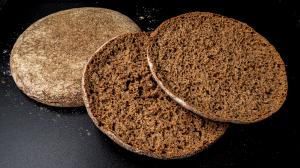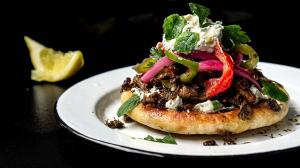A traditional greek RUSK made with BARLEY, SPELT and WHOLE-WHEAT flours, water, olive oil, honey, salt, yeast and some malt powder is not a dry, leftover thing nor a by-product of old or stale bread. It’s a purposely planned and twice-baked preparation that many folks prepare regularly as a replacement for fresh bread, whether for the morning, mid-day snacking, lunch or evening meals, and in this case, for a GREEK SALAD !
The RUSK (or PAXIMADI in Greek) can be the perfect accompaniment for meals and dishes, which is why this weekend’s post is a doubled-up and twinned with the greek salad recipe post coming up right after this recipe (see it here) to enjoy it fully, soaking up and mopping up the lingering vegetables juices and olive oil and remaining brine of the feta cheese as well as the olives, of the salad.
Normally, a quality rusk is made with whole flours, especially barley but I’ve used 4 flours here. It is slightly richer than bread with some fats (melted butter or oil) and sweeteners (sugar or honey) and they are very popular, especially on the islands that are more remote and where they’ve learned to plan ahead and always have a ready supply, whether it is to enjoy them with butter and honey or to accompany savory preparations like cheeses and olives and salads.
The malt powder is an excellent addition for flavor and is something usually added in many products we buy but not always easy to find. It adds a deeper, nuttier, toasted and slightly sweeter flavor to preparations. Liquid malt syrup is more easily available and you can use about 1 ½ times as much as the powder because of its water content but if you have no other option, then just toast some dry flour in a pan until it gets darker and more aromatic and use that as a replacement.
I use 2 identical tin plates each measuring 22,5 cm wide x 2,5 cm high to make the flatbread, one on top and one on the bottom and sealed with aluminum foil, like a home-made dutch oven, but you can use thick aluminum foil plates too or other flat baking dishes, as long as you have two of them.
I start everything off completely covered and sealed in a completely cold oven, to avoid it rising too much in the middle, then I turn on the heat, let it bake at high heat and flip the baking dish over when it’s two-thirds done and bake some more and then uncover and finish baking it. The result is an evenly flat, dense, yet aerated flatbread to start off with and then when completely cooled, I slice it across its width (and sometimes slice it again in smaller pieces) to dry them out in and crisp them up in the oven, to become rusks, until completely cooled.
Anyways, like I said, 2 recipes for you on this weekend of August 31st, so make it and see if the magic of its simplicity will cast its summer spell . . . :)


















